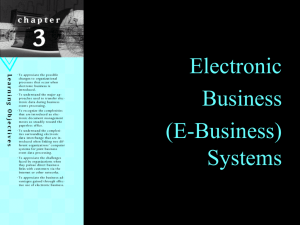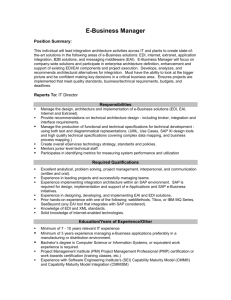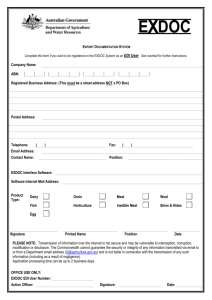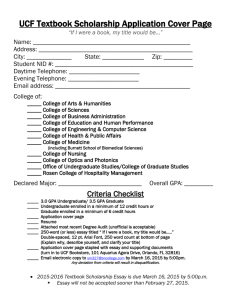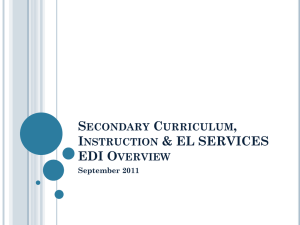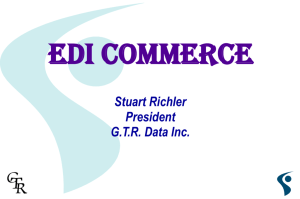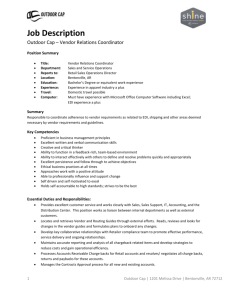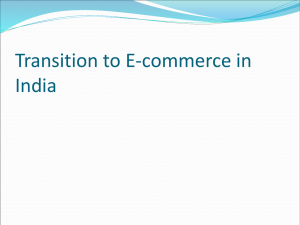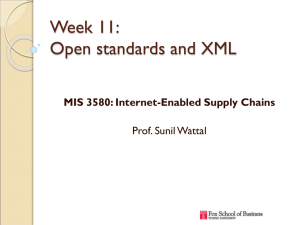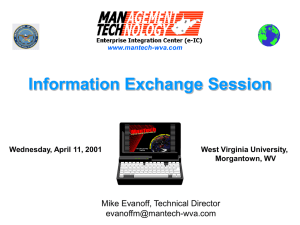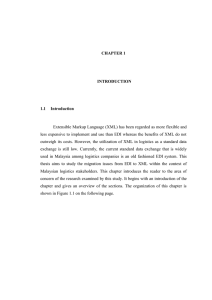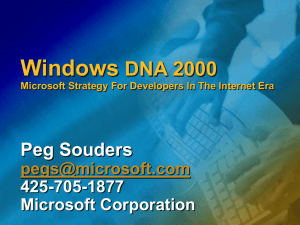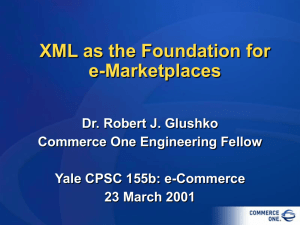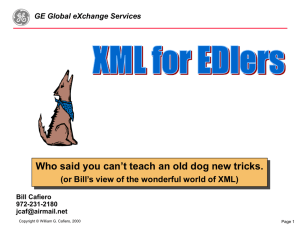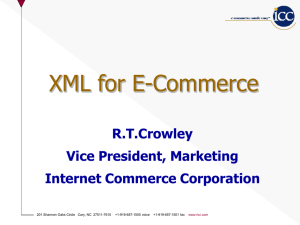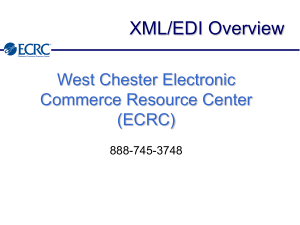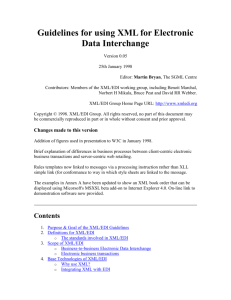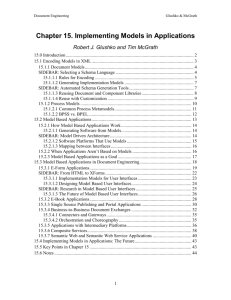Document Engineering for e-Business
advertisement
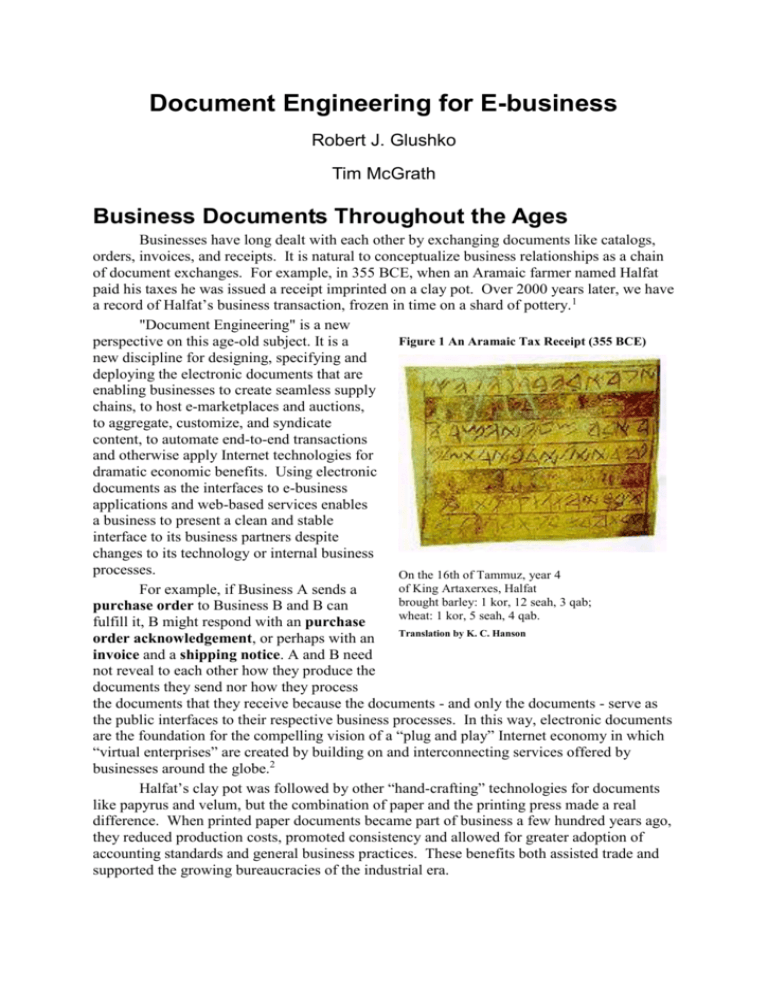
Document Engineering for E-business Robert J. Glushko Tim McGrath Business Documents Throughout the Ages Businesses have long dealt with each other by exchanging documents like catalogs, orders, invoices, and receipts. It is natural to conceptualize business relationships as a chain of document exchanges. For example, in 355 BCE, when an Aramaic farmer named Halfat paid his taxes he was issued a receipt imprinted on a clay pot. Over 2000 years later, we have a record of Halfat’s business transaction, frozen in time on a shard of pottery. 1 "Document Engineering" is a new Figure 1 An Aramaic Tax Receipt (355 BCE) perspective on this age-old subject. It is a new discipline for designing, specifying and deploying the electronic documents that are enabling businesses to create seamless supply chains, to host e-marketplaces and auctions, to aggregate, customize, and syndicate content, to automate end-to-end transactions and otherwise apply Internet technologies for dramatic economic benefits. Using electronic documents as the interfaces to e-business applications and web-based services enables a business to present a clean and stable interface to its business partners despite changes to its technology or internal business processes. On the 16th of Tammuz, year 4 of King Artaxerxes, Halfat For example, if Business A sends a brought barley: 1 kor, 12 seah, 3 qab; purchase order to Business B and B can wheat: 1 kor, 5 seah, 4 qab. fulfill it, B might respond with an purchase Translation by K. C. Hanson order acknowledgement, or perhaps with an invoice and a shipping notice. A and B need not reveal to each other how they produce the documents they send nor how they process the documents that they receive because the documents - and only the documents - serve as the public interfaces to their respective business processes. In this way, electronic documents are the foundation for the compelling vision of a “plug and play” Internet economy in which “virtual enterprises” are created by building on and interconnecting services offered by businesses around the globe.2 Halfat’s clay pot was followed by other “hand-crafting” technologies for documents like papyrus and velum, but the combination of paper and the printing press made a real difference. When printed paper documents became part of business a few hundred years ago, they reduced production costs, promoted consistency and allowed for greater adoption of accounting standards and general business practices. These benefits both assisted trade and supported the growing bureaucracies of the industrial era. Document Engineering for e-Business – Glushko & McGrath “The management of the modern office is based upon written documents.” Max Weber, Wirtschaft und Gesellschaft (1921) The processing of paper documents reached its pinnacle in the 1960s, with offices crammed with wall-to-wall filing cabinets, typing pools, filing clerks and printed business forms and documents everywhere. A contemporary anecdote was that it would take 22 tons of paper to build a 13-ton aircraft!3 Nowadays, many paper documents are being supplemented, or even replaced, by electronic versions. This trend began in the 1980s with the emergence of word processing, document management systems, databases, scanners and OCR technologies, leading to prophecies of the “paperless office” in which information flows easily among the business systems within and between companies. “Paperless trading” between organizations using emerging computer networking techniques and Electronic Data Interchange (EDI, or “the computer-to-computer transmission of business data in a standard format”4) systems evolved as part of this trend. If our Aramaic farmer, Halfat, were now working the wheat fields of Kansas, his tax receipt from the US Internal Revenue Service might be received electronically as an EDI document, somewhat similar to that in Figure 1a. Figure 1a An EDI Tax Acknowledgment (1999 AD) [www.irs.gov] 0120****TRANAb123456789EFILEbINCbbbbbbbbbbbbbbbbbbbbbbbbbbPREPARER’SAGENTbD200102 01199990003201AV729999bbbbbbbbbbbbbPbE#0120****TRANBb1234567893131bDEMOCRATbRDbbb bbbbbbbbbbbbbbbbMEMPHISbTNbb38110bbbbbbbbbbbbbbbbbb9011234567bbbbbbbbbbbbbbbb# 0120****ACKbbbbb444444444199990003201069500000000365+A000Yb0201200100729999006941 000000000000680bbbbbbbbbbbbbbbbbbbbNbb#0120****RECAPbbbbbbbbb00007000067199990003 201000035000000000032000000000007000067bbbbbbbbbbbbbbbbbbbbbbbbbbbbb02059005b# Today, most large companies participate in some form of EDI exchanges, with varying degrees of enthusiasm. A recent informal survey of 200 small- and medium-sized enterprises in the US found that, although 50% of respondents said they currently allow customers to place orders via EDI, they noted that only 1% of their customers are actually doing so, relying instead on telephone and fax5. The complexity and cost of achieving an economically viable EDI system has put the technology beyond the reach of the majority of potential trading partners. One of the reasons for the slow adoption of EDI systems is that despite their electronic format, EDI documents are almost as frozen as Halfat’s clay receipt. They are frozen because the information they contain can’t easily be interpreted or reused except by the software that sends and receives them – just try reading the EDI version of Halfat’s receipt. Changes in technology from pottery to paper to EDI make documents easier to produce and store but does not alter one fundamental aspect. The documents are still static artefacts of implicit business activity encoded in an application-specific fashion, unable to describe their own content or convey the larger business context in which they make sense. The paperless office can’t be realized as long as the meaning of documents depends on specifications buried in the software applications at each end of the document exchange. The Document Strikes Back However, a more recent development is having a profound impact on the idea of what documents are and what can be done with them. This is the idea, pioneered by SGML in the late 1980s and mainstreamed by XML in the late 1990s, of rigorously specifying the logical and semantic structure of information so it can be separated from its presentation.6 Draft 1-6-02 Page 2 of 5 Document Engineering for e-Business – Glushko & McGrath Some parts or components of a document deal with semantically meaningful information such as “name”, “address”, “price”, “title”, or “chapter”. We sometimes refer to this kind of information as the logical structure, or more simply as the content. Documents also contain presentational information such as page numbers, type fonts and sizes, indentation, underlining, and so on.7 These two kinds of information are bound together or confounded, often implicitly, especially with HTML or with word processing systems that use “style tags” to apply formatting to otherwise unlabeled information components. XML separates these two types of information in electronic documents by using markup or tags to make the logical and semantic distinctions explicit. Then, by applying different transformations or styles to the marked up information using the tags as “handles” the information content of a document can remain fixed while its presentation can vary as needed. For example, the same document content could be printed, displayed as a Web page for the World Wide Web, or treated as input data for a computer program. With explicit markup, a document becomes an information source rather than an artefact, because a multitude of different artifacts can be generated from the same source. An XML-encoded document is essentially a database from which other documents can be generated to meet some business need. XML makes documents self-descriptive and dynamic rather than static and frozen. Figure 1b An XML Tax Acknowledgment (2001 AD) [www.ato.gov.au] <?xml version="1.0" ?> <!DOCTYPE NAT4191-9.2001> <NAT4191-9.2001> <PERIOD_DATE_FROM>01042001</PERIOD_DATE_FROM> <PERIOD_DATE_TO>30062001</PERIOD_DATE_TO> <FORM_DUE_ON>28072001</FORM_DUE_ON> <PAYMENT_DUE_ON>28072001</PAYMENT_DUE_ON> <EMAIL_ADDRESS>maddy.maxie@practiceeci.com</EMAIL_ADDRESS> <EFT_CODE>97999 999 999 9360</EFT_CODE> <BILLER_CODE>75556</BILLER_CODE> <TAX>500</TAX> <TAX_REFUND>200</TAX_REFUND> <NET_AMOUNT_FOR_THIS_STATEMENT>300</NET_AMOUNT_FOR_THIS_STATEMENT> </NAT4191-9.2001> Thus as we enter the third millennium since Halfat, his descendent in Dalwallinu, Western Australia might soon receive a tax receipt as an XML document similar to that in Figure 1b. Unlike the EDI version in Figure 1a, this document has clearly defined information components that can be understood both by people and by machines. Just as an XML business document can have a formal specification of its components and the rules by which they combine, XML can also be used to specify the business processes or rules that operate on documents. What if Business A sends a purchase order to Business B and expects a purchase order acknowledgement in return, but Business B’s normal business process when it can fulfill an order is to send an invoice and a shipping notice? Business A can send Business B a process specification document that proposes a sequence of document exchanges for handling purchase orders. This enables A and B to align their business interaction by ensuring that the appropriate documents are processed in the correct sequence. Treating both business documents and business processes in the same explicit way completes the transition from business documents as static artifacts of unknown business processes to a new duality in which business documents and the business processes they enable, invoke, or support as two aspects of the same thing - a “yin” and “yang” for electronic business. This unification of content and process is analogous to the concept of “state” and “behavior” in object-oriented software development in which a “class” contains specifications of data structures and the functions they support. Draft 1-6-02 Page 3 of 5 Document Engineering for e-Business – Glushko & McGrath The Document Engineering Approach Document Engineering is about identifying, specifying, and deploying the appropriate documents needed for e-business applications. Internet-friendly technologies like XML and Java give us some new opportunities, but the questions that must be answered are not new: What businesses provide products or services that I want? What products or services can my business offer to others? What do they offer? How can I describe what I offer so it makes sense to my potential customers? What information do other businesses need from me to obtain their products or services? What information do I need from them to interact with me? Are our information requirements compatible? How is the information produced and consumed by each of our businesses best organized in our documents? Are our documents and processing expectations compatible? What other information does the recipient of a document need to understand and process it? Can my company produce and consume documents efficiently given our organization, technology, and internal business processes? Since these are old questions, of course there are plenty of techniques for answering them and many solutions and standards that can be applied. We believe, however, that a new perspective that views business models as a network of document exchanges can best exploit the potential of XML and the Internet for e-business while preserving legacy investments in EDI and enterprise software systems. Our approach encourages the reuse of pre-Internet solution patterns and reference models while enabling them to evolve to address more ambitious business and technical challenges posed by the vision of “plug and play” Internet business services. For example, the goals of interconnecting business systems to automate supply chains or enterprise planning aren’t new, but doing so while minimizing point-to-point integration and maximizing interoperability is only possible when the most modern modeling techniques and architectures are employed. It is premature to cast Document Engineering in stone as a prescriptive methodology but we can recommend some insights into classical analysis, modeling, and implementation methods. The tasks of Document Engineering include determining an appropriate business model, de-constructing existing documents and information sources, identifying the requirements for new documents and information products and then developing specifications that can be unambiguously and effectively communicated. These designs need to accommodate the business processes and the contexts in which the documents will be used. And, of course, the documents and the processes that produce and use them must be implementable and deployable according to a realistic Information Technology architecture and plan. Draft 1-6-02 Page 4 of 5 Document Engineering for e-Business – Glushko & McGrath References List 1 2 http://www.stolaf.edu/people/kchanson/taxreceipt.html Tenenbaum, J., Chowdhry, T., and Hughes, K. ECo System: An Internet Commerce Architecture. Computer, May 1997, 48-55. 3 Metzgen, Fred (1990) Killing the Paper Dragon, Heinemann Newnes (Great Britain) http://www.unece.org/trade/untdid/texts/d300_d.htm#e 5 http://www.ecomworld.com/magazine/issues/article.cfm?ContentID=1054 6 World Wide Web Consortium. XML in 10 Points. http://www.w3.org/XML/1999/XML-in-10-points 7 Maler, Eve and El Andaloussi, Jeanne (1996) Developing SGML DTDs, Prentice Hall (USA) 4 Draft 1-6-02 Page 5 of 5
